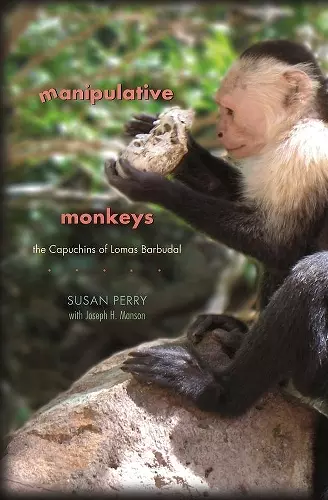Manipulative Monkeys
The Capuchins of Lomas Barbudal
Susan Perry author Joseph H Manson author
Format:Paperback
Publisher:Harvard University Press
Published:10th Apr '11
Currently unavailable, and unfortunately no date known when it will be back

Capuchins are no regular monkeys. They have huge brains, and seem about as smart and 'cultured' as any ape. I know of no better guides to their social life than Susan Perry and Joe Manson, who have devoted their lives to studying these often overlooked creatures in the jungles of Costa Rica. The result is an account that is bound to fascinate and surprise, because the behavior of wild capuchins exceeds our wildest imagination. -- Frans de Waal, author of Our Inner Ape
This book takes us into a Costa Rican forest teeming with simian drama, where since 1990 primatologists Perry and Manson have followed four generations of capuchins. The authors describe behavior as entertaining—and occasionally as alarming—as it is recognizable.
With their tonsured heads, white faces, and striking cowls, the monkeys might vaguely resemble the Capuchin monks for whom they were named. How they act is something else entirely. They climb onto each other’s shoulders four deep to frighten enemies. They test friendship by sticking their fingers up one another’s noses. They often nurse—but sometimes kill—each other’s offspring. They use sex as a means of communicating. And they negotiate a remarkably intricate network of alliances, simian politics, and social intrigue. Not monkish, perhaps, but as we see in this downright ethnographic account of the capuchins of Lomas Barbudal, their world is as complex, ritualistic, and structured as any society.
Manipulative Monkeys takes us into a Costa Rican forest teeming with simian drama, where since 1990 primatologists Susan Perry and Joseph H. Manson have followed the lives of four generations of capuchins. What the authors describe is behavior as entertaining—and occasionally as alarming—as it is recognizable: the competition and cooperation, the jockeying for position and status, the peaceful years under an alpha male devolving into bloody chaos, and the complex traditions passed from one generation to the next. Interspersed with their observations of the monkeys’ lives are the authors’ colorful tales of the challenges of tropical fieldwork—a mixture so rich that by the book’s end we know what it is to be a wild capuchin monkey or a field primatologist. And we are left with a clear sense of the importance of these endangered monkeys for understanding human behavioral evolution.
Capuchins are no regular monkeys. They have huge brains, and seem about as smart and 'cultured' as any ape. I know of no better guides to their social life than Susan Perry and Joe Manson, who have devoted their lives to studying these often overlooked creatures in the jungles of Costa Rica. The result is an account that is bound to fascinate and surprise, because the behavior of wild capuchins exceeds our wildest imagination. -- Frans de Waal, author of Our Inner Ape
Susan Perry and Joseph H. Manson‘s book reveals capuchins as having social lives as rich and as complex as those...of humans...Perry‘s book, with her husband and research partner, is far more than just stories about monkeys’ social lives. It offers fascinating biology from Costa Rica’s tropical forests, including the small, somewhat ugly, Machiavellian capuchin monkeys. They act as the focus for a discourse that ranges over “big questions”: why evolve large brains and intelligence; how do youngsters learn group-typical behavior; why does lethal aggression occur? These questions are embedded in the human drama of fieldwork; snakes, bugs of all kinds, plants with deadly toxicity, ill-fated collaborations, deep friendships and human poachers...We desperately need such studies to be sustained. Let’s hope this fascinating book will go some way towards achieving this aim. -- Phyllis C. Lee * Times Higher Education Supplement *
- Nominated for W.W. Howells Book Prize 2010
ISBN: 9780674060388
Dimensions: unknown
Weight: unknown
368 pages